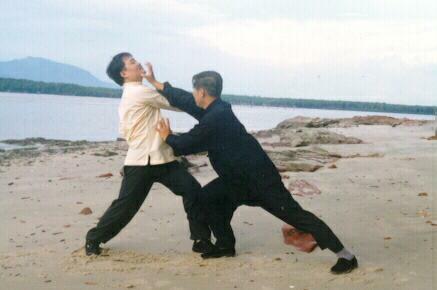SHAOLIN KUNGFU AND TAI CHI CHUAN

Shaolin Kungfu
Question
From your webpage, I do know that both Shaolin Kungfu and Tai Chi Chuan are extremely beneficial to health and can also be used for defending oneself. However, what does not seem too clear to me is the main difference in the benefits between these two. Is Tai Chi Chuan meant more for older people while Shaolin Kungfu is meant for younger people, or do they both give similar benefits with different styles of training? Is that why most masters I heard of practice both?
-- Lim, Singapore
Answer
Both Shaolin Kungfu and Tai Chi Chuan are great martial arts originally developed by the Chinese but now practised by people of different race, culture and religion. While there are similar in their general aims and benefits, they are also very different in their philosophy and practice.
Generally speaking, both Shaolin Kungfu and Tai Chi Chuan aim to provide benefits attaining combat efficiency, health and vitality, longevity, mind expansion and spiritual joy. The details and approach, however, are quite different. For example, in their practice, Shaolin Kungfu is normally done in a fast, powerful manner, whereas Tai Chi Chuan is performed slowly and gracefully. This gives the general, but not exactly correct, impression that Shaolin Kungfu is “hard”, whereas Tai Chi Chuan is “soft”. What many people do not realize is that if we perform Shaolin Kungfu slowly, it may look like Tai Chi Chuan; and if we perform Tai Chi Chuan fast, it may look like Shaolin Kungfu.
Shaolin philosophy is Zen in nature, whereas that of Tai Chi Chuan is Taoist. Hence, Shaolin techniques are simple, direct and effective, whcih are characteristic of Zen Buddhism. Tai Chi Chuan techniques are flowing and continuous, reflecting the water process regarded as the supreme of the five elemental processes in Taoism.
Shaolin philosophy pays much attention to compassion and wisdom, the two halmarks of Mahayana Buddhism, of which Zen Buddhism is a major school. Shaolin disciples, therefore, avoid hurting their opponents in combat, and meditation (the path to cosmic wisdom) constitutes an integral part of their training.
Taoist philosophy pays much attention to going along with nature, and attaining longevity and immortality. Tai Chi Chuan disciples, therefore, flow with their opponents' movements (instead of going against them), and chi kung (the art to good health and longevity, and for those who are ready, to immortality) forms an essential part of their practice.
It is not true that Shaolin Kungfu is for the young and Tai Chi Chuan for the elderly. Both arts are for people of all ages. My oldest student, Robert Trout — you may view his photograph here — started Shaolin Kungfu with me when he was 87! Tai Chi Chuan training can be very tough: most untrained youngsters cannot remain at the Tai Chi Stance for more than 5 minutes. Nevertheless, Shaolin gymnastics (not real Shaolin Kungfu) is more suitable for younger people, and Tai Chi dance (not real Tai Chi Chuan) more suitable for older people.
Whether Shaolin Kungfu and Tai Chi Chuan give similar benefits with different styles of training, depends on how we look at the question. In general terms, the answer is yes. In more detailed analysis, the answer is no, or sometimes yes and no.
In its widest sense the fundamental benefits of Shaolin Kungfu and Tai Chi Chuan are similar; in a narrower sense, they are not. For example, relatively speaking, Shaolin training makes a person agile, whereas Tai Chi Chuan training makes him stable.
In its widest sense, the fundamental training of Shaolin Kungfu and Tai Chi Chuan are similar: both involve the training of body, energy and mind. In a narrower sense, they are different. Relatively speaking, Shaolin training is “forceful”, whereas Tai Chi Chuan training is “graceful”.
Shaolin masters and Tai Chi Chuan masters practise only their chosen one art, not both. Some of them may know both arts, but they devote most of their time to the practice of only one. I am refering to real masters, not teachers who readily teach one or the other according to the demand on the market. If a Shaolin master teaches Tai Chi Chuan, or vice versa, it is usually due to special circumstances. If you look at history, not a single Shaolin, Tai Chi Chuan or other masters, claimed to be equally good at any other martial art.
Some recent examples are as follows: Hoong Hei Khun, Wong Fei Hoong, Chen Herng, Huo Yuan Jia and Wang Zi Ping — Shaolin masters. Yang Lu Chan, Wu Yu Xiang and Hou Wei Zhen — Tai Chi Chuan masters. Yang Lu Chan was good at Shaolin Kungfu before he learned Tai Chi Chuan from Chen Chang Xin. But after he had mastered the art, Yang Lu Chan practised and taught only Tai Chi Chuan.
LINKS
Courses and Classes
